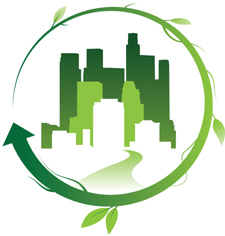|
Sustainable (Green) Building
 Earth Day was April 22, so it seems fitting to bring more awareness to green and sustainable building. Many people may wonder, “Why bother with the added work and/or expense?” Earth Day was April 22, so it seems fitting to bring more awareness to green and sustainable building. Many people may wonder, “Why bother with the added work and/or expense?”
At some point, everyone will have to follow with some green initiatives. The Earth is simply not sustainable and we will begin to run out of certain natural resources that are needed in order for us to survive. If more people changed their attitude and worked towards the same goal, we could prevent more environmental damage and, in many cases, reverse some of the damage already created.
What is Green or Sustainable Building?
The U.S. EPA says, “Green building is the practice of creating structures and using processes that are environmentally responsible and resource-efficient throughout a building’s lifecycle from planning, design, construction, operational use, maintenance, renovation and deconstruction or demolition.”
This requires close cooperation of the contractor, the architects, the engineers and the client/owner at all stages of the project for a successful outcome.
Benefits of Going Green
When it comes to sustainable building, the savings generated in energy, water, maintenance, operations and healthcare can offer many short and long-term investment returns. Here are some of the benefits from green building.
- Energy Efficiency & Water Conservation – Optimizing energy and water resources will not only decrease the use and wastage of natural resources but will also put less strain on the local infrastructure.
- Improved Indoor Air Quality – With fresher air indoors due to less air pollutants from byproducts of the construction materials, breathing will be easier – especially for anyone with compromised breathing health conditions.
- Reduced Carbon Footprint – Less waste is produced and the release of harmful gases reduced.
- Increased Property Values – Green built properties are in demand for their sustainable components that lower maintenance costs. A higher rent can often be charged and the building can be sold for a higher price.
- Increased Employee Productivity – People working in green built buildings can focus better on their work and become more productive with cleaner air and more natural light.
- Improved Employee Attendance – An environmentally friendly workplace creates positive attitudes and higher morale, which makes people want to come to work. The overall health of employees may also be improved, which means fewer sick days.
- Promotes Company Values – Building green projects shows your clients and employees you value environmental awareness and those in the community.
- Government & Utility Incentives (in some locations) – Grants, tax exemptions, local rebates and other incentives may be available for green built properties.
Does Going Green Cost More?
Some people have the common misconception that building green costs too much and they just can’t afford it. While it’s true it may cost a bit more upfront during construction, you have to consider the long-term savings that will be achieved. With less energy and water consumed, utility bills and overall maintenance will be less for the lifetime of the building. Going green should really be viewed as an investment more than anything else. In addition to saving natural resources and utility/maintenance expenses, you’re investing in future generations – as well as an investment that will help the environment.
Goals of Green Building
When the decision is made to go green, the ultimate goal is to help sustain the environment without disrupting the natural habitats around it. Even the smallest changes can help to promote a better planet Earth, and a better place for all of us to live – not just humans, but plants and wildlife as well.
Perhaps a well-known quote sums it up best, “We do not inherit the Earth from our ancestors; we borrow it from our children and grandchildren.”
|